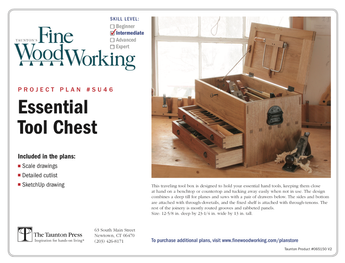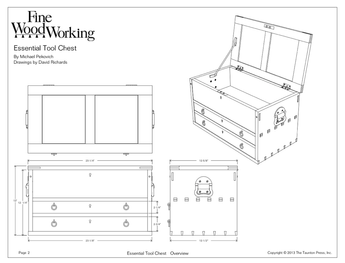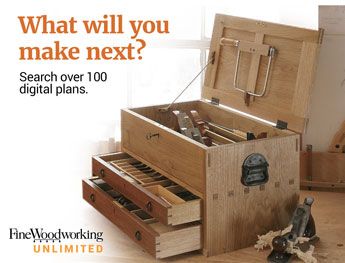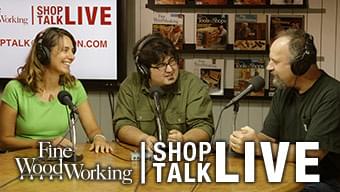I have read that when joining boards into a table top, or other such item, that it is desireable to have a slight hollow in the middle of the joint and clamp it tight. I have heard this is called a sprung joint. I find it highly suitable as my jointer is incapable of making a board straight. How much of a gap is desired? Usually I make tops in smaller, under 12 inch segments, to allow them to pass through my planer. Once they are relatively smooth I join the two halves into a top. Is any spring desired in that joint or will it not close up?
jeremy













Replies
Jeremy,
I'm sorry but I don't accept your premise. If your jointer is capable of consistntly make an edge with, say, 1/32" sprung in the center, then it can be adjusted to make a perfectly straight edge as well. Go back and check the basics of set-up. If you must err, then do it to the side of having a sprung joint, but there's really no reason that any jointer cannot be adjusted. The results also have a lot to do with your pressure as you work.
DR
No fixed answer, since longer boards can be sprung more than shorter. I usually just go for a space that can be closed with just a bit more clamp pressure than the unsprung ends.
Mike Hennessy
Pittsburgh, PA
jeremy,
Boards (or table top segments) as wide as 12" or wider, can be glued up with a little spring. You don't want to have to use excessive clamp pressure to close up the gap, 1/16" over 5 feet is enough. A 2' long x2' broad top would have little to no spring, if the joint is in the center of its width.
What you want to avoid is a joint that's high in the middle, requiring pressure to close the ends up. There is a possibility of seasonal shrinkage causing the ends of the panel to split as moisture leaves it. Moisture will leave thru end grain faster than the face of the panel, putting additional strain on the already stressed joints.
Regards,
Ray Pine
I totally disagree with the sprung joint concept. I put it in the "old wives tale" category. You want the boards to fit together perfectly before gluing. I want my glue ups to stay together, not have a built in spring that will tend to open up down the road. Why put stress into your joint? If your edges are not coming off the jointer perfectly straight, there is a problem with either your set up or your technique. Clamping a sprung joint will glue starve the ends from excess pressure and may not make a good bond in the middle.
Most woodworking joinery requires nice straight lumber for repeatable accuracy. I wouldn't be comfortable running a bowed board against a saw, router or shaper fence. If you are not getting straight stock off the jointer, it will cause problems with other processes. You will always be tweaking or compensating for the discrepancy, unnecessarily. Once you get the jointer set up correctly and your technique for feeding right, your world will change in all aspects of the job.
Beat it to fit / Paint it to match
Jeremy,
You've gotten some interesting answers on both side of the aisle on this one.
The best answer I've seen here, so far, is "it depends."
For me, as a general rule of thumb, I normally use about 1/64th or 1/32d inch. Just enough that a sliver of light is visible through the center of the joint.
(I also live in a place where the relative humidity does not change all that much, and, most of the time, is very dry: 10% to 20% RH; so...the movement of the wood is somewhat lesser of a problem than it is in areas where the RH swings are more dramatic.)
Ring and Hammer both make a good point about the adjustments of your jointer, and if you can get the edge absolutely straight, then a rub joint will work just as well (although doing rub joints for longer pieces of wood is a bit of a logistical challenge) as a sprung joint.
I tend to agree with David Charlesworth's contention that it is very hard to get an edge absolutely "straight," whereas it is relatively easy to make a board very slightly concave, and that is much easier to compensate for (i.e., a sprung joint) than a convexity (which on an edge joint would require excessive clamping pressures and will likely fail or open up within a short time).
I would also suggest that you try jointing your edges with a hand plane. With a little practice, you'll find that you can do much finer and more accurate work than you're likely to get from your electric jointer.
Tschüß!
Mit freundlichen holzbearbeitungischen Grüßen aus dem Land der Rio Grande!!
James
It does take a bit of effort to get a perfectly mated pair of boards to be joined, but it is mostly a matter of persistence rather than high skill. (By "perfect" I mean no light visible between the boards with them being pushed together with very light hand pressure.) It does require a well tuned jointer, but that should be done in any case. It can also be done with sharp hand planes.
The key is to identify where the two boards touch. Using a light behind the boards on edge in a darkish room, mark the places where they touch. (Often you can see the source of the imperfection such as a grain feature.) Then with the jointer set for a light cut, lower the board onto the cutters and take a short pass over just that area, or areas. Then make a full length cut without changing the jointer setting, taking care to make as even a pass as possible. A few iterations of this kind will see the light disappear.
Edited 10/17/2006 12:46 pm ET by SteveSchoene
Steve,
You make several good points here -- and I certainly won't argue against having a well-tuned jointer (or any other tool, for that matter).
I am getting to be pretty good a keeping my edges square to the faces, but have yet to have mastered (or even apprenticed -- LOL) a "straight" edge; the best I can do so far is the very slightly concave edge mentioned in my last post. Since the planes I use for jointing (#5½, #6C, #7, or #8C -- depending on the length of the board) are very well-tuned, I expect that at least some of this is a matter of subtle changes in my technique -- little tweaks that my brain/muscles have not yet figured out.
At any rate, the slightly concave technique works well for me. That's the reality/practicality of multi-board panel-making for me, at my current level of skill. I certainly won't argue against the "ideal" of having straight edges for (edge/rub) jointing; I'm just not there yet, so I make do with what I am able to reliably accomplish, and keep trying to improve my technique and skills.
-----
On a slightly different subject, I have enjoyed and have learned a lot from your posts on finishing and finishing techniques. Thanks for sharing your knowledge and experience.Tschüß!
Mit freundlichen holzbearbeitungischen Grüßen aus dem Land der Rio Grande!!
James
For some reason I thought you were working with a jointer. Yes, it is a matter of technique with hand planes. But it's not just a how you hold your mouth matter, it calls for active adjustments--eg. if your straight edge shows a concave edge, then focus on removing a little more at the ends. A little more pressure, etc....
Actually, I'd think that getting a concave edge is a pretty good sign as far as technique--the beginners usual problem is exactly the reverse. You obviously have mastered the shift from toe to heel.
`
I was using a hand plane for my earlier projects, and was doing not too badly with it. Right now I'm making a set of six tables and I wanted to speed things up. Late last year I picked up an old Rockwell 37-220 six inch jointer and I having been using it to make my table tops and lower shelves. I know I need to improve my technique (since I don't have a manual for it and there is less information online than I imagined there would be) since I'm don't really know what the correct techinque is. Today I picked up the new FWW with the jointer article and will read it. I was able to find lots of information on machine set up online and the machine is set up well. The blades are pretty sharp and well set, although the outfeed table may be a little low on the far end. Its just a crack of light and I'm trying to take care of it. I have some scraps that are just over a foot long and I can joint them perfectly but the two foot pieces for the table get a small bow. I'm open to any suggestions on techinque.
jeremy
There can be a few different things that result in not getting a straight edge on the jointer. I don't know what the article says but I assume you know how to get the knives set properly and the outfeed at the right height in relation to them. The next thing is how you feed the lumber. Once about one third of the length is over the outfeed table, you take a few baby steps along with the piece and transfer all your pressure to the outfeed only. If you have any pressure on the infeed side or straddled over the knives, you'll have trouble getting it correct. Another issue can be the size in width, when edge jointing. A 2" piece will easily flex under your pressure. You have to be easy. One other factor can be the speed at which you feed the lumber. If you are set up correctly you shouldn't see any knife marks on your edge. Going too fast will make them show up, correct set up or not. You can get a feel for the right speed by taking a piece and feeding it fairly fast, look at the edge, slow down and try again until the marks disappear.A jointer is much easier to use if the tables are nice and clean and a coat of paste wax applied. Otherwise, you fight with friction that prevents smooth and easy movement of the work. Your Rockwell jointer is the same as some Deltas and many others. The set up for knives and table height is the same for all straight knife jointers. You don't have any jack screws for your knives and your fence and mechanism is different than more modern models as it is end mounted. It's a good little jointer.Beat it to fit / Paint it to match
All the advice you've received is good. I had a slightly different problem, but my solution may work for you too. I aligned & clamped two boards about every 2 feet of length to the top of straightened 2X6s such that their edges were ~3/8-inch apart. I ran a 1/2-inch router edge trimming bit between them removing material from both faces which were to be joined. Of course, an edge guide positioned the router & the 2X6s had notches for bit clearance. There is no spring in such a joint, however, if you feel that you need it. I was joining veneered MDF. I used custom-fitted biscuits to align the joint. They were solid & uncompressed hardwood with a tight sliding fit. You really ought to tune that jointer, but maybe my method will work in the meantime. It was dead on for me. LOL!!Cadiddlehopper
Hi Jeremy,
I often have students come up to me at school to "let me know" that the jointer they've been using isn't functioning properly. Most of the time, however, the challenge has less to do with the jointer than the user's technique. I'm not suggesting this is the case with you, although technique can definitely be a factor when using a jointer.
As to sprung joints, I've never understood why one would be necessary when using modern adhesives. If you are unable to achieve a straight edge using your jointer, you can always shoot the edge with a handplane before gluing-up.
Good luck,
-Jazzdogg-
"Don't ask yourself what the world needs. Ask yourself what makes you come alive, and go do that, because what the world needs is people who have come alive." Gil Bailie
This forum post is now archived. Commenting has been disabled